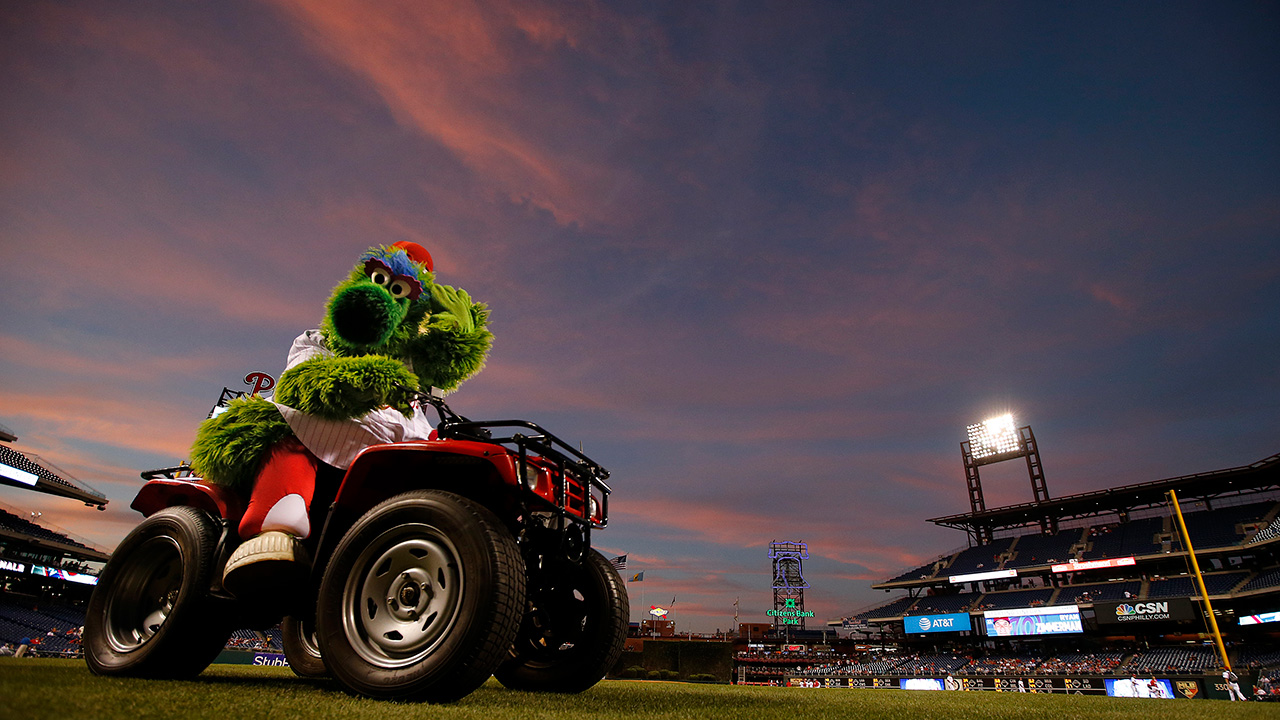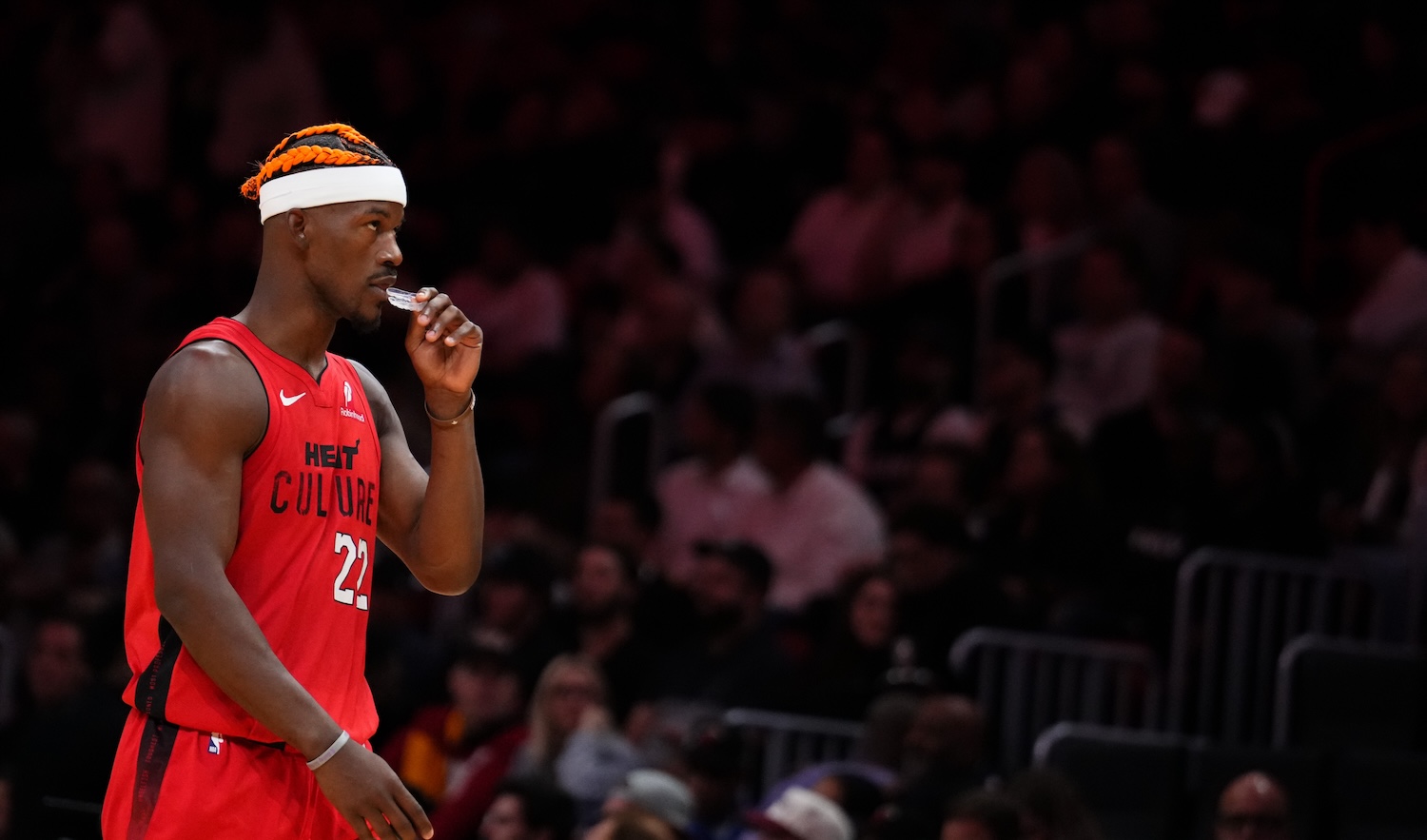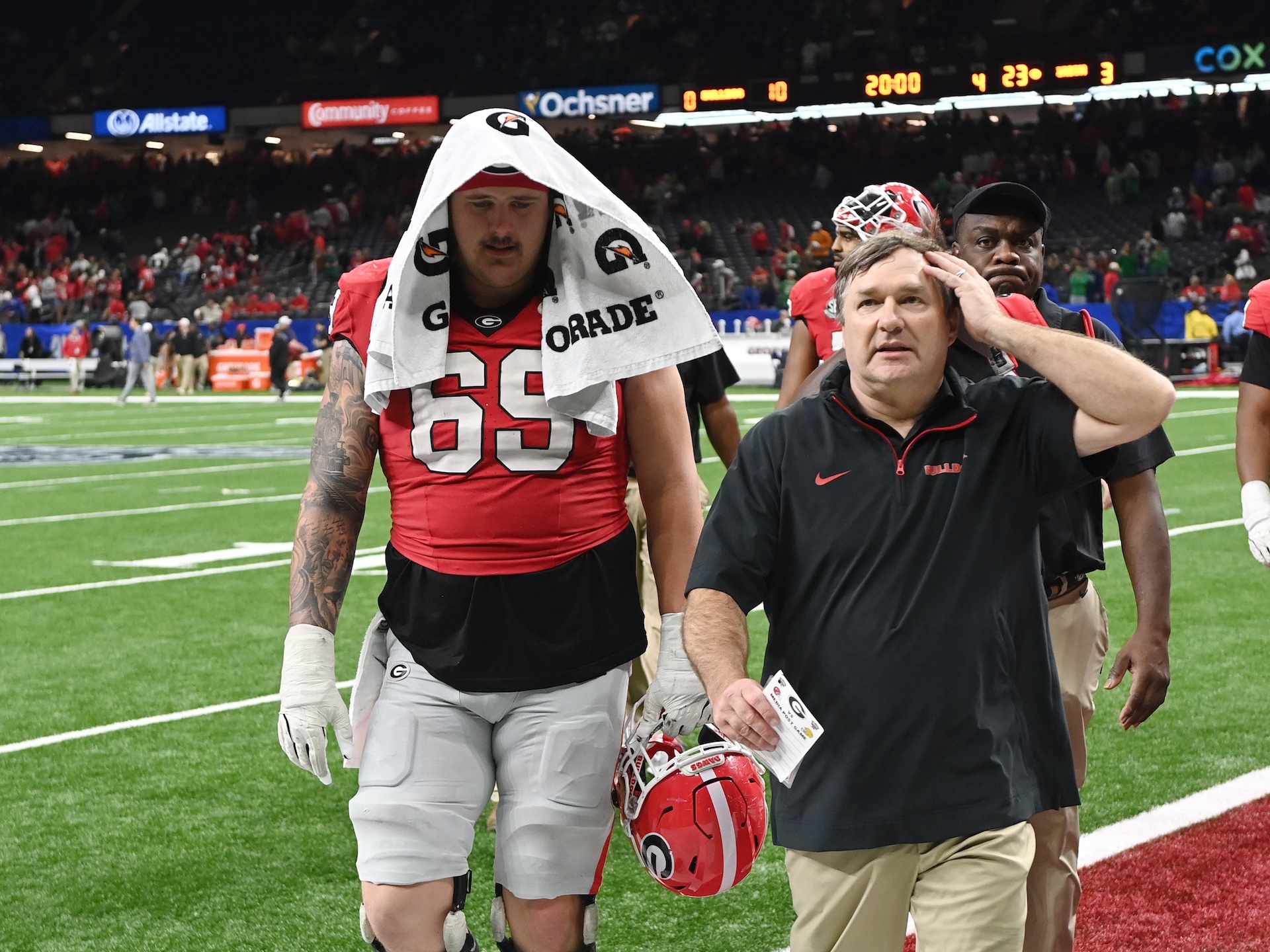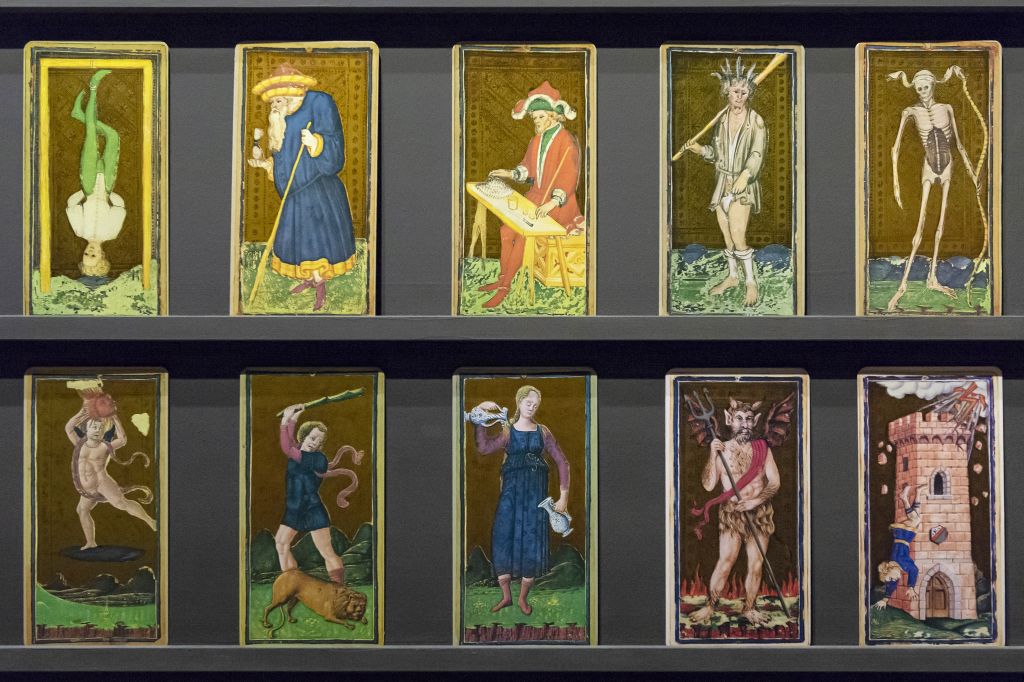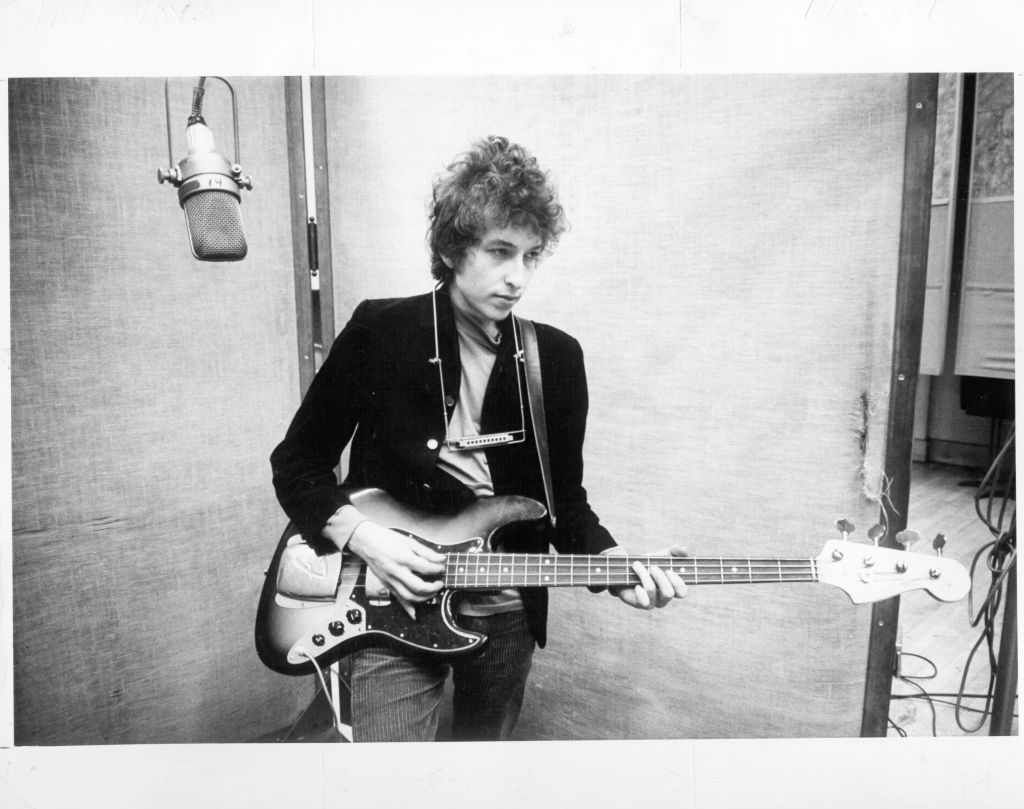When the Phillie Phanatic faced his first big moment, he choked. The Phillies mascot debuted on April 25, 1978 at Veterans Stadium, and was formally introduced to children on local kids show Captain Noah and His Magical Ark three days later by Phils closer Tug McGraw. The rookie from the Galapagos Islands had a pretty good first year, all told. Hal Bodley, then sports editor of The News-Journal of Wilmington, said fans didn’t yet know his name. Though they just called him “The Bird,” Bodley wrote that “thousands and thousands” of fans had “fallen in love.”
But on August 22, 1978, the Phanatic learned what life in the big leagues was like. He met his match. The San Diego Chicken—then known as the KGB Chicken, after a radio station—performed with the Phanatic that night, and the verdict was clear. “The Chicken won,” The Philadelphia Inquirer’s Don McKee wrote. “Hands down.” The city’s tabloid agreed. “Last night KGB Chicken won the competition,” the Daily News’ Mary Flannery wrote.
Not only was he trounced by a visiting chicken, but the Phanatic was accused of dereliction of duty. Flannery, who called the Phanatic “P.P.” throughout her story, wrote that the Chicken “plunked himself down next to Mary Sue Styles, the glamorous ballgirl. But getting close to Mary Sue wasn’t enough. Chicken grabbed her, toppled to the ground and rolled around on the AstroTurf.” Styles’s reaction to this assault was to ask the Phanatic: “Where were you when I needed you?” Dave Raymond, the Phillies employee who played the Phanatic, admitted defeat: “I feel like I just lost a football game. Chicken Man is awesome.”
“The Bird” caught on, but he was not always loved. An incident where the Phanatic marched on the field at halftime of a Villanova/Delaware football game became newspaper fodder for a week. Tubby Raymond was the Delaware coach; Dave, his son, had been the punter before he became the Phanatic. Raymond said he got into the costume and did the performance on a whim. Bodley—a longtime USA Today baseball editor, MLB.com writer, and early Phanatic chronicler—recapped the scene in November 1978:
The Delaware halftime shows will never make it to Broadway. In fact, most of them are forgettable to say the least. But yesterday, the Phillie Phanatic made it.
The largest Delaware Stadium crowd of the year, 20,189, was treated fo the most hilarious halftime show in decades. The Phillie Phanatic danced with a Golden Girl, he swiped a Villanova majorette’s baton and twirled it. Well, almost.
Then, when the band was trudging around the field, he livened it up by marching along and sticking out that crazy tongue at tuba players.
“The band members kept saying, ‘Great job, we loved it,’” Raymond related after the game. “They were really excited about the Phonetic coming to Delaware Stadium.”
The band direction, Dr. David P. Blackinton, however, did not see much humor in the Phanatic’s spontaneous appearance.
“He told me after it was over that he was really unhappy. He was really upset,” said Raymond. “I kept telling him I was sorry, but it didn’t help. All the time he’s giving me all this static, the band members are congratulating me.
“You know, it’s really funny. I’ve worked with over 50 bands this year and they have all loved me—except for this idiot today.”
Marching bands tend to take themselves seriously. The Delaware band is no exception. But even a scramble band might be upset about being told it will never make it to Broadway, among other slights. They were not happy! The News-Journal ran at least seven letters to the editor about Bodley’s story about the Phanatic. Here are some excerpts:
- In this article Bodley praised a grown man, Davie Raymond (the coach's son), whose only claim to fame is that he dresses up like a buffoon (Phillie Phanatic) and runs around in crowds.
- Bodley even justifies his comments by quoting a bystander who remarked to the Phanatic, “Don’t worry about it… nobody’s ever heard of the Delaware band outside of Newark.” Everyone knows that after a football game in Newark, the typical Delaware fan is three sheets to the wind, and when the Delaware team wins a big game (which is rarely) the less-than-sober fans will say anything.
- In doing so, the attention of the audience is taken away from the 150 people who have worked hard and usurped by a mediocre ex-football player and a hanger-on who for some reason needs attention.
- I contend there are two idiots involved: Hal Bodley, who thought Raymond's actions were wonderful, and Davie Raymond, the Phillie Phanatic, who never grew up.
- You can insult my school, you can insult my state, you can insult my country, you can even insult my mom's apple pie; but don't ever insult my band!
- An insult to a fine marching organization, such as our band, is bad enough, but the personal attacks, such as the ones that were lodged in the article in question, are plain libelous.
- Granted, the Phanatic did liven up the show, but I almost had to march over him at one point—if he had stuck around a moment longer, he would have had a trumpet in his face; he was standin’ where I aimed to go, and I had to go there, the Phillie Phanatic notwithstanding.
- As for Mr. Bodley, if he ever takes MU101 Appreciation of Music, I hope he flunks it.
- Mr. Raymond is very good at what he does, and in my opinion would have been a welcome addition to the Delaware band's halftime shoe if he had demonstrated enough common courtesy to coordinate his appearance… Mr. Raymond not only rudely interrupted the Delaware Band show, but managed to intrude on the Villanova show as well.
- When Mr. Bodley editorialized ”most Delaware halftime shows are forgettable to say the least” my blood started to boil.
- If he thinks that he can do a better job he is welcome to come to Delaware Stadium, borrow my tuba (787) and try. He certainly has the wind for it.
University of Delaware band fans weren’t the only ones unhappy with the Phanatic. When the Phanatic battled the Chicken, the Phillies didn’t like the show, either—though they objected to both mascots. “I didn’t exactly enjoy it,” said pitcher Larry Christiansen after he got the win in the Phillies’ 5-3 victory. “There was too much going on on the field. I didn't appreciate it. I'm warming up and he’s 20 feet away from the plate. I can't help but see that agglomeration of color against a green backdrop. It's fine for the fans, but I didn't like that running around on the field so much, especially so close to the plate." Phillies manager Danny Ozark agreed: “I think maybe it detracts from the game." There's no reason to believe the Phanatic influenced Ozark's lineup construction, but the game was one of the eight in Mike Schmidt’s career in which he led off. Schmidt was hitting .237 when Ozark moved him up the order. He had a 1.198 OPS in six games leading off that season.
Ozark moved Schmidt back down the order, and he stayed there. Schmidt would win three MVPs in the 1980s and was inducted into the Hall of Fame in 1995. Things got better for the Phanatic, too. By 1980, Phillies fans were complaining about NBC not showing the Phanatic enough during the World Series, the first title the Phillies ever won. When I was a kid going to baseball games in the 1990s, after Schmidt's peak, the Phanatic was as much of an attraction as any of the players on the field—moreso, most years, given how the Phillies played. In the interest of disclosure, I should note here that I think the Phanatic rules. I danced in a conga line and slid through his legs when the Phanatic appeared at a friend’s wedding in 2013, and consider it a highlight of my life.
Raymond retired as the Phanatic and now helps other teams create mascots. He had a hand in the latest sensation, the Philadelphia Flyers’ Gritty. Tom Burgoyne, now the man inside the Phanatic costume, has written 11 children’s books starring the Phanatic. Everyone knows the name of “The Bird” now. The Phanatic went into the Mascot Hall of Fame 20 years after Schmidt went into the baseball one.
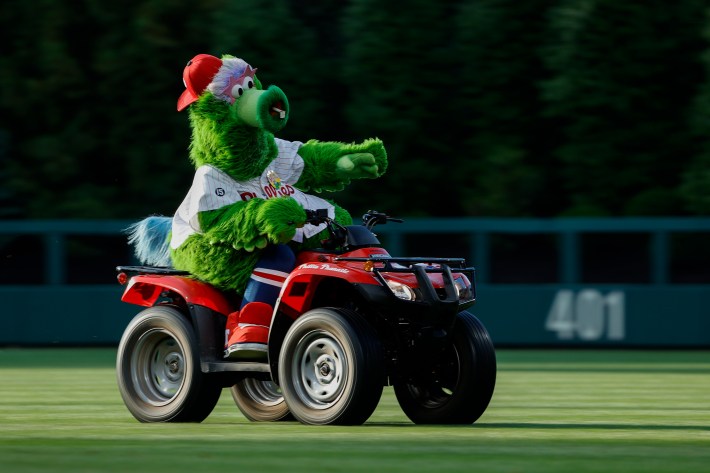
But something was different with the Phanatic over the last two years. Wildly different, actually. He had “evolved,” according to the Phillies. He had a reshaped nose, slightly different hair, and stars behind his eyes. He had new shoes and socks, a blue tail, and scales on his arms. The Phanatic costume had always changed—the earlier version, like lots of mascots, was much jankier—but this change had ulterior motives. The Phillies were attempting to make sure that nobody else got their hands on the Phanatic.
It actually started in August 2019, when the Phillies filed a lawsuit against the company of Wayde Harrison and Bonnie Erickson, the Phanatic’s creators. The Phils accused the pair of attempting to “make the Phanatic a free agent” by canceling a 1984 agreement that allowed the Phillies to use the mascot “forever.” The Phillies claimed that they were the ones who made the Phanatic popular, not its creators. “Over the last 41 years, the Club has devoted millions of dollars to developing and promoting the Phanatic,” the lawsuit said. “Without the Club’s contributions, the Phanatic would not have been a character at all.”
The relationship between the Phanatic’s creators and the team has almost always been strained. Harrison/Erickson Inc. said they offered the Phillies the copyright to the creature when they created it, but the Phillies passed. For the first few years Harrison/Erickson owned the merchandise rights—they got 10 percent of every merch sale—while the Phillies had the performance rights. (A 1984 story says at the time they charged $500 for a commercial appearance and $300 for a non-commercial one.) Harrison/Erickson sued the Phillies in 1980, accusing the team of violating the licensing agreement by not paying them for Phanatic merchandise. That suit was thrown out, but Phanatic dolls and other merchandise did get pulled from circulation. “After a two year absence, Phillie Phanatic dolls have returned to the Delaware Valley!” an ad read when they returned.
Harrison/Erickson sold the “exclusive rights” to the Phillies in the fall of 1984, giving up merchandising rights. (Oddly, when news of that broke the following year, the Phillies’ Dave Montgomery told The News Journal that, eh, maybe the Phanatic wasn’t really part of the Phillies plans: “Part of it depends on how long we think there is going to be a Phillie Phanatic. For the foreseeable future, there will be a character of some sort. Whether or not it will continue as the Phanatic, we don't know at this point.") The 2020 lawsuit says the Phillies paid $215,000 for the rights at the time.
But starting in 2013 the federal Copyright Act allowed creators to reclaim post-1977 copyrights 35 years after transferring them. Harrison/Erickson weren’t really looking to make the Phanatic a free agent per se, but they were interested in getting their copyright back. The company attempted to force the new, fake Phillie Phanatic off the field, but a judge ruled that the altered Phanatic was allowed to stay due to the Derivative Works Exception of the law.
This didn’t really matter in 2020; with no fans in attendance during the regular season, the only time the Derivative Works Exception Phanatic appeared before fans at games that year was at spring training. But with fans back in the stadium last year, the new, weirdly scaly Phanatic was back. And he was hated. Look, I don’t have any citations for this. But I live in Philadelphia and I followed the 2021 Phillies pretty closely. And I can tell you that, as frustrated as fans were with the team, they phucking hated this new Phanatic.
The Phillies apparently noticed this, too. The month after a team the Phillies swept to begin the 2021 season won the World Series, the Phillies settled with Harrison/Erickson. Terms were not disclosed. The two sides were cordial again. Erickson and Harrison were quoted in a news release: “Ever since we created the Phanatic in 1978, Philadelphia has been his home. We are thrilled to see the original Phanatic back where he should be, in Philadelphia, for the fans of the Phillies.” The Phillies released a statement on a fake letterhead parodying Michael Jordan’s first return to the NBA: “I’m back.” The costume returns to its non-scaly version this year, and Philly fans will be grateful. Even if the team doesn’t end up doing much this year, at least the original Phanatic will be back where he belongs.
